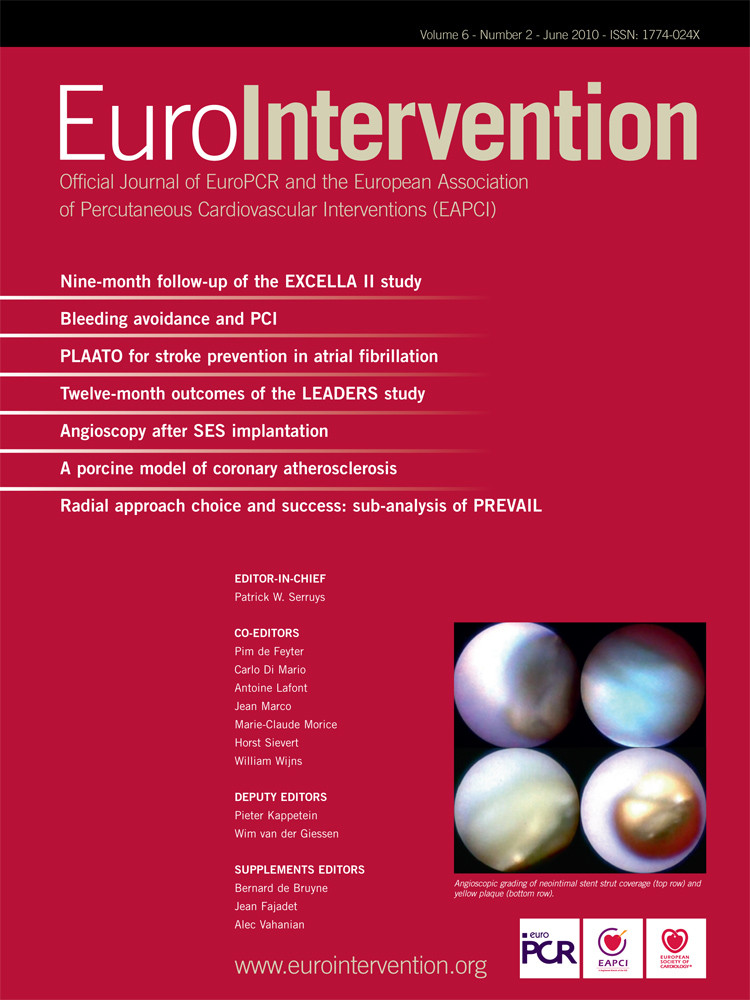Abstract
Aims: This registry has aimed to collect data on cardiac catheterisation procedures in Europe in 2006.
Methods and results: Numbers and types of procedures were collected by means of a standardised questionnaire from all adult percutaneous cardiac intervention centres in Europe. Questionnaires were collected from all national member societies of the European Association of Percutaneous Cardiovascular Interventions (EAPCI): 23 of 30 countries provided data. The analyses were performed for all countries based on the most up-to-date available data. With 2.5 million coronary angiographies performed, the overall number of diagnostic procedures continues to increase (+8%) at a faster rate than the population (+0.6%). The number of percutaneous coronary interventions (PCI: >1 million) paralleled this increment (+10%). A marked disparity prevails between different countries in Europe. There was a comparative slight reduction in the stenting/PCI ratio (0.85). Use of drug-eluting stents (DES) remained virtually unchanged in comparison to the previous report, despite “safety concern warnings” regarding their use in 2006.
Conclusions: Interventional cardiology in European countries is ever expanding. Despite the drug eluting stent firestorm that took place in the course of 2006, the number of implanted DES even increased slightly. Mortality and complications remained low. Among the noncoronary procedures, percutaneous shunt closures increased, albeit moderately.
Introduction
Starting in 1992, a European wide survey of interventional procedures in all member countries of the European Society of Cardiology (ESC) has been performed annually to record temporary trends in percutaneous cardiac interventions in Europe.1-15 The report of these interventions in 2006 represents the 15th edition of the yearly census, and summarises the real-life practice of catheter-based cardiac interventions in 30 European countries. The year 2006 witnessed startling presentations at the 2006 ESC-World Congress of Cardiology held in Barcelona warning against a high stent thrombosis risk with the use of drug-eluting stents.
Methods
A detailed questionnaire, together with instructions and examples for completion, was sent to the presidents or designated delegates of each national society of cardiology represented in the European Society of Cardiology. These national leaders distributed it within each country to all facilities performing diagnostic and/or interventional cardiac catheterisation. A summary data sheet, supplied by the national representatives, was used to aggregate data per country. These forms were available online at the ESC web services. Finally, the data were entered into the central database and analysed. In the case of missing or incomplete data, the national representatives were reminded repeatedly for completion or correction. Cyprus, Denmark, Luxembourg, Portugal, Romania, The Netherlands, and Turkey did not report their data. For these countries, the most up-to-date available data were substituted to allow a meaningful comparison with prior years. The definitions of diseases and procedures were those of previous reports. Briefly, coronary angiography (CA) was the term for diagnostic angiographic visualisation of the coronary arteries, independent of whether or not an intervention was performed. Percutaneous coronary intervention (PCI) was used for coronary angioplasty with or without stent placement, regardless of the number of segments treated. Ad hoc PCI was defined as PCI performed directly following the diagnostic procedure during the same session. Stent procedures were PCIs with stent implantation regardless of the number of stents used.
Prior to submission for publication, the national representatives were asked to review the manuscript for accuracy.
Results
Figures for the year 2006
Table 1 lists the number of centres and operators, as well as the major coronary procedures (coronary angiography, PCI and coronary stenting) for each country. The numbers per population are also given.

Catheterisation facilities
The numbers of cardiac catheterisation centres per million inhabitants in Europe remained basically unchanged in 2006 (2.6±1.2) as compared to 2005 (2.4), with still the highest density seen in Germany (5.6) and the lowest in Bulgaria (0.9). The number of cardiac catheterisation rooms per million inhabitants in 2006 was 3.0±1.6, with the highest reported density in Iceland and Switzerland (6.5) and the lowest in Bulgaria and Slovakia (1.3). A slightly decreasing mean of 1,091±317 coronary angiographies and 448±144 PCIs were performed per catheterisation room. The mean numbers of operators per million inhabitants were 11.5±7.5 and ranged from 27 in Switzerland to four in Slovakia.
Coronary angiography
A total of 2,481,605 coronary angiograms were reported for 2006 (Figure 1), an 8% increase compared with 2005. The mean population-adjusted number in 2006 was 1,747 procedures (PCI) per million inhabitants, representing an increase of 9% compared with 2005.
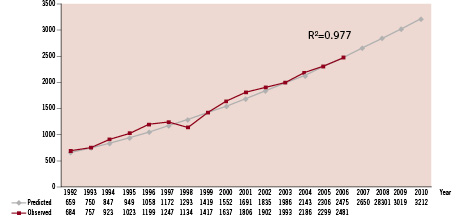
Figure 1. Observed and predicted coronary angiograms expressed in thousands from 1992 to 2006 per million inhabitants in Europe, based on the “consumption method” for prediction medicine on the data 1992-2004 with R2= 0.977 (see reference 14 for details).
Percutaneous coronary intervention (PCI)
A total of 1,001,000 percutaneous coronary interventions were reported for 2006, a 10% increase compared with 2005. As in past years, the smallest numbers of procedures per million people were reported in countries from eastern Europe (e.g., Slovakia 573) nevertheless showing a relevant increase in number of procedures as compared to previous reports. With the exception of Iceland (–7%), Norway (–4%), and Sweden (–2%), all countries reported increases in procedures. Some European countries reported particularly high relative increases (Bulgaria +59%, Latvia +48% and Slovenia +33%). Ad hoc procedures averaged 70% of all PCIs (65 in 2005 and 46% in 2004). The mean ratio of PCIs to coronary angiograms was 0.43 (2005: 0.40). The ratio of PCIs to coronary angiograms ranged from 0.34 in the United Kingdom to 0.78 in Slovenia. Multivessel interventions in one session remained fairly stable with 15% of all PCI (2005 and 2004: 18%). The same holds true for interventions for acute and ongoing myocardial infarction with 18% in 2006 (17% in 2005 and 19% in 2004).
Coronary stenting
A total of 854,164 stenting procedures were reported in 2006, resulting in an increase of 6.6% compared with 2005 (801,215 procedures) (Table 2). The ratio of coronary stenting to PCI procedures averaged 0.85 (2005: 0.87). Unchanged to the preceding year, most countries reported ratios >0.7. Drug eluting stents were used overall in about one third (32%) of stenting procedures in 2006 (26% in 2005); the highest rate being seen in Italy (88%), the lowest in Bulgaria (1%).
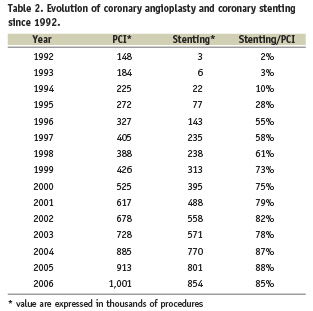
Noncoronary interventions
The major noncoronary procedures (alcohol ablation for septal hypertrophy, valvuloplasty, shunt occlusion, coarctation angioplasty, and atrial appendage occlusion) are listed in Table 3. Among these, percutaneous closure of patent foramen ovales (PFO) and atrial septal defects remained the leading procedures. They show a constant progression with 6,220 procedures in 2006, +24% since 2005. For PFO closure, Switzerland is the leading country in Europe with 72 cases per million inhabitants. Data concerning the new addition to interventional cardiology, percutaneous aortic valve replacement, were not yet collected.
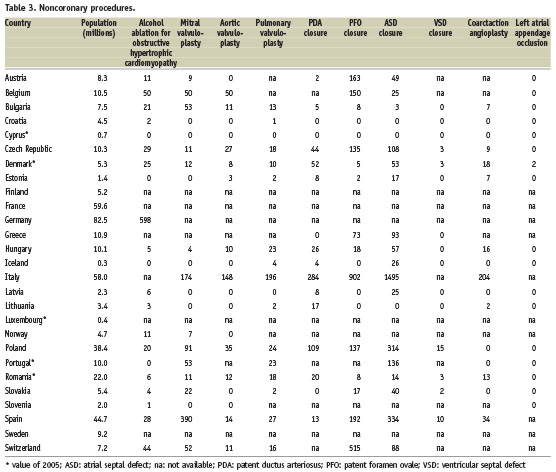
Other devices
Other therapeutic devices (directional atherectomy, rotablator, laser catheter or wire, ultrasound therapy, brachytherapy, clot catcher/remover) were reported in slightly increasing numbers for a total of 19,864 cases (15,645 in 2005) in 2006 (+27%), mainly driven by rotablator procedures (+23%) and clot catcher/clot remover/filter (+70%). The most frequently used additional diagnostic techniques in PCI remain intravascular ultrasound (in 1.7% of PCI procedures) and intracoronary pressure measurements to assess the fractional flow reserve (in 1.0%).
Complications
Reported mortality showed no significant change since 1992, and was reported 0.4% in 2006 (3,763 cases per 1,000,752 PCIs) compared to 0.3% in 2005. The need for emergency coronary artery bypass grafting (CABG) has remained virtually unchanged (0.2% of PCIs), whereas the incidence of PCI-induced myocardial infarction was reported with a slight increase at 0.8% (0.6% in 2005; it is doubtful that all centres measure enzymes the day post-procedure and/or use universal definition of MI).
Discussion
Since its inception by the European Society of Cardiology, the aim of the reported registry has been to demonstrate availability and use of cardiovascular diagnostic and therapeutic procedures within Europe. Although the design of the survey is retrospective and based on self-reporting (subject to bias and under-reporting of complications), the European Survey provides a unique insight of the contemporary practice of interventional cardiology within Europe with a target-population of more than 570 million people.
With 2.5 million coronary angiographies performed, the overall number of diagnostic procedures continues to increase (+8%) faster than the population (+0.6%) (Figure 1). The number of percutaneous coronary interventions topped the one million mark, with an increment of 10% in comparison with 2005, which can be seen in parallel with the number of coronary angiographies. The number of percutaneous interventions for acute and ongoing myocardial infarctions remains stable at 18%, consistent with recently published data by Widimsky et al (primary PCI per all PCI in Europe ranging from 5 to 39%)16. Coronary stenting showed a significant deceleration in growth (–9% of the prediction, Figure 2). A variety of reasons might account for this.
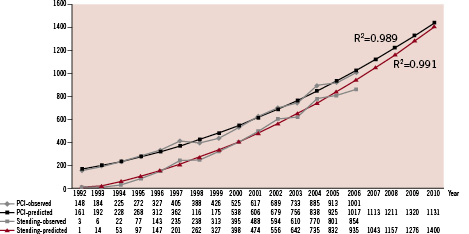
Figure 2. Observed and predicted PCI and stenting procedures expressed in thousands from 1992 to 2006 per million inhabitants in Europe, based on the “consumption method” for prediction medicine on the data 1992-2004 with R2=0.989 for PCIs and R2=0.991 for stenting procedures (see reference 14 for details).
DES use rose to more than 312,000 cases in 2006. Once again, a large variability was reported, ranging from Bulgaria (1%) to Italy (88%) with a European mean of about 36%. The impact of safety concerns regarding DES voiced since early 2006 seemed to have caused a slight slowing down in the increase of the use of such devices17.
For noncoronary procedures, only closures of atrial shunts have shown a constant progression during the past five years. This trend probably translates by the fact that the simpler and safer occlusion techniques get, the more lightly decisions are being taken to close shunts, in particular PFOs. This is bound to continue – if not accelerate – in the future.
Limitations
Registry data are approximate. Sources of potential error include missing external validation of the raw data provided by the local institutions and communication errors between the institutions, national coordinators, and the central database. Under-reporting of complication is germane. However, the involvement of the national societies of cardiology ensures conformity with national registries and statistics and thus guarantees the best achievable level of accuracy for elementary data on coronary angiography, PCI, coronary stenting, and noncoronary catheter-based procedures.
Acknowledgement
We are indebted to all the representatives of the national societies of cardiology who participated in this survey. Furthermore we acknowledge the effort of all single centres in collecting the surveyed data and completing the questionnaires. The principal data coordinators for each individual country participating in this survey are alphabetical order: Austria: V. Mühlberger, Belgium: V. Legrand, Bulgaria: G. Mazhdrakov, Croatia: A. Ernst, Cyprus: P. Nicolaides, Czech Republic: P. Kala, Denmark: S. Helqvist, Estonia M. Peeba, Finland: M. Laine, France: D. Blanchard, Germany: F. van Buuren, Greece: G. Papaioannou, Hungary: G. Fontos, Iceland: K. Evjolfsson, Italy: F. Piscione, Latvia: A. Erglis, Lithuania: R. Navickas, Luxemburg: J. Beissel, The Netherlands: K. Koch, J.Bronzwaer, Norway: T. Melberg, Poland: A. Witkowsky, Portugal: P. Helder, Romania: D. Deleanu, Slovakia: V. Fridrich, Slovenia: M. Noc, Spain: J.A. Baz Alonso, Sweden: S. James, Switzerland: M. Maeder, H. Rickli, Turkey: M. Degertekin, United Kingdom: P. Ludman.
